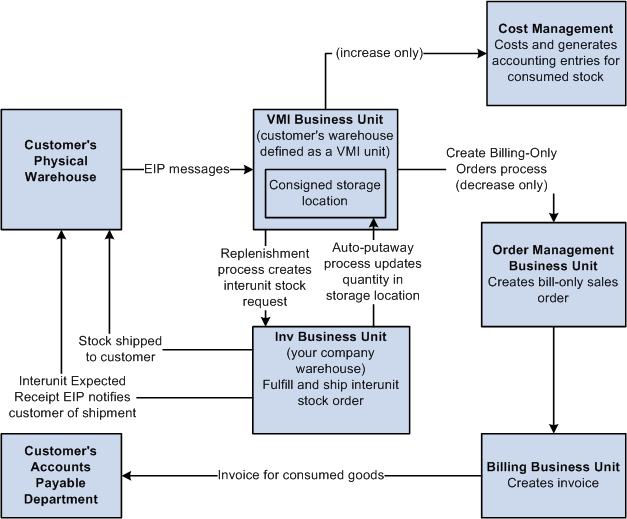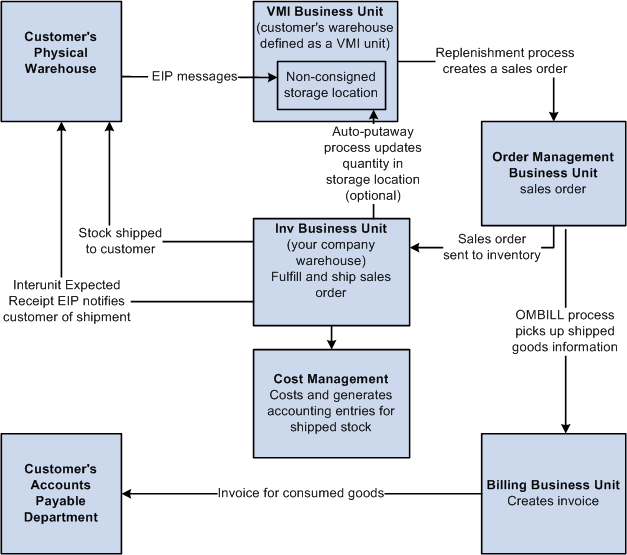Understanding Vendor Managed Inventory
Vendor managed inventory is a supply chain management strategy in which a supplier manages goods that are located in a customer's warehouse. The goods can be consigned or non-consigned stock. The consigned stock is owned by the supplier until the customer consumes it, and the non-consigned stock is owned by the customer when the customer receives it.
As the supplier, you will create a Vendor Managed Inventory (VMI) business unit, which represents your customer's inventory. This business unit will have storage locations that contain items and item quantities. Storage location in the VMI business unit correspond to Ship-To locations for a customer. These items and item quantities in the storage locations will match the item quantities at the customer site.
You can implement this strategy across the enterprise by integrating functions in PeopleSoft Inventory, Cost Management, Order Management, and Billing.
These terms are often used with VMI:
Term |
Definition |
|---|---|
Consignment |
Material at a customer site that is owned by a supplier. The customer has the physical inventory at their location, but does not have ownership of the material. The quantity of material is tracked in the PeopleSoft system. The material cost of the consigned goods belongs to the supplier. |
Customer |
The entity that is purchasing goods from a supplier. The goods are stored at the customer's physical location. |
Non-Consignment |
In the case of managing consigned inventory, material at a customer site that is owned by the customer. The quantity of material is tracked in the PeopleSoft system by the supplier. |
Supplier |
In the case of managing consigned inventory, the supplier is the manufacturer or distributor who is using the PeopleSoft system. |
This diagram illustrates the supplier managed inventory process for consigned items. Your organization (as the supplier) creates a PeopleSoft Inventory VMI business unit for storing stock that is located at your customer's warehouse, store, or other location. When you send consigned stock to the customer's location, you will create an interunit transfer (MSR) to send the consigned stock from your company warehouse to the VMI business unit. The Interunit Expected Receipt service operation can notify the customer that the shipment is in transit. On a regular basis, your customer communicates how much stock has been used. This can be done using PeopleSoft service operations. The stock levels in the VMI business unit are adjusted for the customer's consumption, and then PeopleSoft Cost Management calculates and records the cost of the consumed items and PeopleSoft Order Management creates bill-only sales orders which are used to create invoices in PeopleSoft Billing. Use the replenishment process within the inventory VMI business unit to generate interunit transfers to stock the customer location to the appropriate stock levels:

This diagram illustrates the supplier managed inventory process for non-consigned items. For non-consigned inventory stock, the sales is recorded when stock is shipped to the customer location. The customer location is represented by an PeopleSoft VMI business unit. A sales order is created in PeopleSoft Order Management for both the initial stock purchase and any replenishment processes with the VMI business unit. The sales order causes stock to be shipped from your company warehouse to the VMI business unit, shipping costs to be recorded in PeopleSoft Cost Management, and invoices to be created in PeopleSoft Billing. The Interunit Expected Receipt service operation can notify the customer that the shipment is in transit. Service operations (EIP messages) can also be used to communicate the consumed stock at the customer site so that the replenishment process can restock the VMI business unit:

An individual in your organization is typically assigned to the customer and referred to as the VMI manager. The VMI manager works with the customer and agrees upon which items and item quantities to stock at the customer site. This information is entered into your enterprise system for the VMI business unit, in the VMI Replenishment menu.
On a periodic basis, which is agreed upon between the VMI manager and the customer, the customer sends transactional data to notify the VMI manager of item activity and to synchronize item quantities. Transactions are written to the transaction table (TRANSACTION_INV), and item quantities are updated in the VMI business unit.
When consumption transactions are reported for consigned goods, those transaction quantities are eligible for billing to the customer. The Create Billing-Only Orders (IN_BILL_VMI) process creates a bill-only sales order for those transaction quantities, which is used to create an invoice to send to the customer.
The VMI manager initiates the replenishment process to determine if quantity is needed at the customer site. If quantity is needed:
The replenishment process creates an interunit material stock request (MSR) for consigned items.
The replenishment process creates a sales order for non-consigned items.
The items on these sales orders go through the standard fulfillment and billing process.
The fulfillment process is used to ship the items to the customer. During the Deplete On Hand Quantity Requests process the auto-putaway process may be initiated and updates item quantities in the VMI business unit. Alternatively, customers can report the receipt of goods when they arrive at the customers' facility.
The customer can return consigned or non-consigned items:
If the customer returns a consigned item, the VMI manager creates an return material authorization (RMA) from the source inventory business unit to the supplying inventory business unit.
If the customer returns a non-consigned item, the PeopleSoft Order Management RMA form is used.